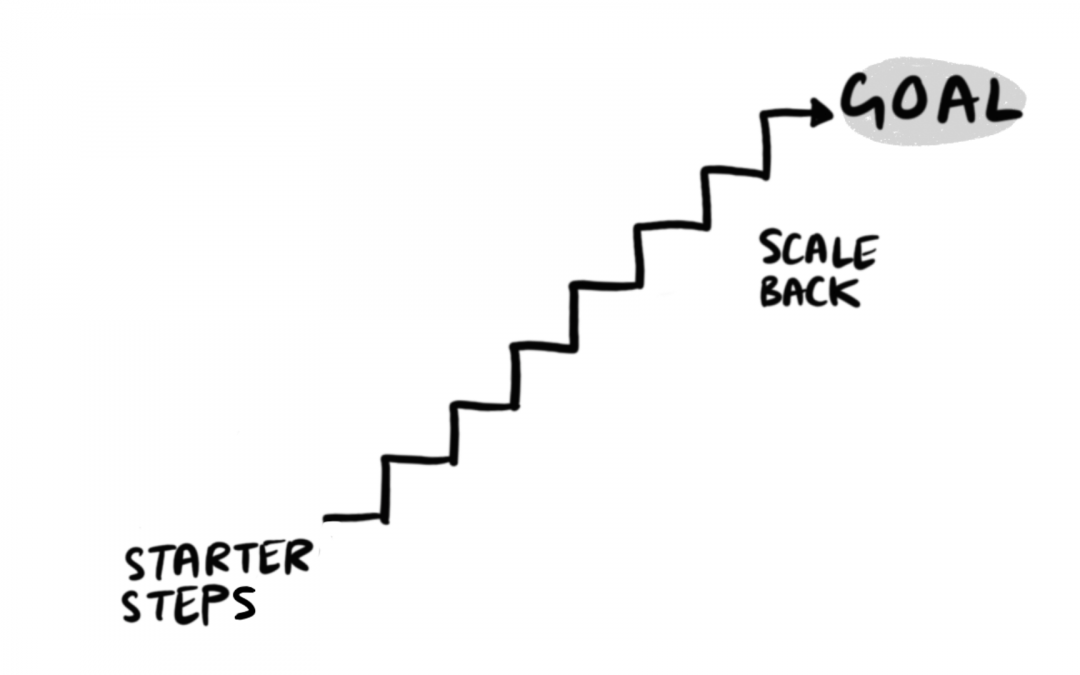Your writing dreams are big, but the way to achieve them is to think small. If you want to build a new routine or change your behavior, the research says you need to start tiny. Here’s how to use small steps to build great progress.
You’ve got a great idea for a book, it’s all planned, the research is in place and you’re excited to get it written. But you haven’t started yet.
Many writers face the same problem. Take 20th century novelist John Steinbeck:
“When I face the desolate impossibility of writing 500 pages, a sick sense of failure falls on me, and I know I can never do it. Then gradually, I write one page and then another. One day’s work is all I can permit myself to contemplate.”
Steinbeck’s tactic was to focus on writing one page at a time, one day at a time. This is a tried and tested approach to making progress on your plans – breaking the big goal down into smaller parts.
But what if those parts were really small? What if the first step in writing a book might be to sit at your desk for one minute without turning on your computer, or it could be writing three words a day. That’s right, one minute here or three words there.
The science of small
Focussing on a large goal stimulates our body’s fight or flight mechanism. The more important that goal is to you, the more you have riding on the outcome, the greater the feeling of fear becomes. Fear overwhelms you, the goal feels unachievable and you procrastinate, delay and take no action.
The solution is to set goals so small, that you don’t engage these primitive survival responses. Instead, you bypass the fear centres of your brain.
“Accomplish the great task by a series of small acts.” Tao Te Ching
Robert Maurer, Director of Behavioral Sciences at Santa Monica UCLA Medical Center, explains:
“Small easily achievable goals let you tiptoe past your amygdala, keeping it asleep and unable to set off alarm bells. As your small steps continue and the cortex starts working, the brain begins to create ‘software’ for your desired change, actually laying down new nerve pathways and building new habits.”
Not only do you avoid triggering the fear centres of the brain, this small approach will create new neural networks to support your writing habit longer term. But let’s not get ahead of ourselves by thinking long term. First, we need to start.
Getting started with small steps
Let’s get back to those three words. Writing three words isn’t at all scary, it won’t take much time, and it would be difficult to come up with an excuse to not do it. It might feel trivial and insignificant, but taking small steps work, however big your goal is.
The first step is just that, an action that gets you going. It succeeds in breaking down your resistance and overcoming the fear of starting. Once you’ve mastered your first step, you’ll be eager to take a larger one, writing a full sentence, a paragraph or a page.
Over time, the repetition gets you writing a little every day, building a routine and making progress towards writing your book.
“A journey of a thousand miles must start with the first step.” Lao Tzu
Take your first step with tiny habits
Tiny Habits is an approach from social science researcher BJ Fogg, the founder and director of the Stanford Behavior Design Lab. His research with over 60,000 people found that anyone can develop new habits and routines, however ambitious, if they start tiny.
Failure to develop new habits and routines has nothing to with bad character, willpower or self-discipline. Fogg urges us to stop blaming ourselves. It’s not our fault – it’s bad design! He provides a positive approach to design new behaviors, best summed up with his mantra: “People change best by feeling good, not by feeling bad.”
So, forget willpower, let’s get tiny.
“People change best by feeling good, not by feeling bad.” BJ Fogg
2 approaches to identify your tiny step
BJ Fogg’s example of a tiny step is based on his own failure to create a flossing habit even though he needed and wanted to floss. His tiny step was to floss one tooth. It was the start he needed to develop his flossing behavior.
Once you know what behavior you want to build, such as writing every day, you need to identify the smallest possible way to start. There are two approaches for this.
1. Starter step
A starter step will be something very small that gets you going, for example, opening your notebook or naming a document. It’s not about doing any writing – yet. It will turn into a bigger habit, but by keeping the bar low you’ll start a routine and be able to keep it alive.
2. Scaling back
This approach gets you to look at the behavior you want, like working every day on your 70,000-word novel, and shrinking it. So rather than write 1,000 words a day, write 10. Turn up every day, repeat and the routine will build. Over time you’ll increase how many words you write.
I’ve been using the tiny habits method for all sorts of activities since 2014 when I took Fogg’s course to help me do daily physio exercises. I recently used the approach to make time for reading the Tiny Habits book, by following his approach to swapping out bad habits for good. Rather than scroll through my phone at breakfast I now read business or non-fiction books. I might not read for very long, or get through that many pages, but my pile of completed books is mounting up. I’ve developed a behavior that meets my goal of reading more. I’ve taken out the willpower: ‘I really should read more’ and replaced it with a tiny habit that works.
>> Read more: Finding time to write: create a daily writing routine
Build a rock-solid habit from your tiny step
To grow your tiny step into a full blown habit, there are a few more tips to follow. Read the book for the full system, but for now, follow the A, B, C of habits.
Fogg, calls this ABC the anatomy of tiny habits, where A = Anchor, B = Behavior, C = Celebration. Following this approach will embed a habit into your brain and help it grow.
- Anchor Moment: Identify an existing routine (like brushing your teeth or eating your breakfast) or an event that happens (like a phone notification). The anchor moment acts like a cue to remind you to do the new tiny behaviour.
- New Tiny Behavior: A simple version of the new habit you want, such as flossing one tooth or reading a bit of a business book. You need to do the tiny behavior immediately after the anchor moment.
- Instant Celebration: You celebrate immediately after doing the new tiny behavior. This is a vital yet often over looked or misunderstood part of the habit-formation process. It should be something you do to create positive emotions, such as saying, “I did a good job!”
>>Read more: How to keep writing using rewards
A note on celebration
Fogg has found that emotion create habits, so while it might feel weird to celebrate writing three words, it can make or break a habit. His research found that the people who embraced celebration were the most successful in creating habits quickly.
You need positive emotion generated from an immediate celebration to embed the behavior. As Fogg says: “when you celebrate effectively, you tap into the reward circuitry of your brain.”
Celebration makes you feel successful. It can be applied to help you develop bad habits, such as getting addicted to online gaming, which can come down to the rush you experience after hitting a high score.
However, celebration is hard for writers especially if their profession isn’t one that goes in for emotional displays (say academic writing) or if you are from a culture that is more understated (if, for example, you are English like I am and rather introverted).
“When you celebrate effectively, you tap into the reward circuitry of your brain.” BJ Fogg
Take time to think of a celebration that feels authentic to you, the behavior, and the environment you are in. Popping open a bottle of champagne in the university office might not be the way to go.
>> Read more: 7 step training plan for running a personal writing sprint
How small steps lead to great progress
Here’s your step-by-step guide to achieving great things by starting tiny.
- Name the behavior you want to change, focus on the activity rather than a goal or outcome or output.
- Generate a list or mind map all the small steps you could possibly take to start.
- Select one based on how keen you are to do it and how straightforward it is to do. You need both the motivation and ability to get going.
- Find your anchor moment – an existing routine or event that will prompt you to do the step.
- Think of a way you can celebrate immediately on completion of the step. Again, it might help to generate a few ideas of how do to this so you find one that works for you.
Each tiny action you take will mount up, and through repetition, you’ll reprogramme your brain to embed the habit. Soon those small steps will lead to significant change and growth.



